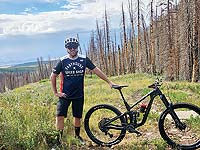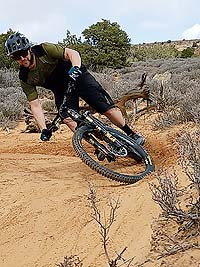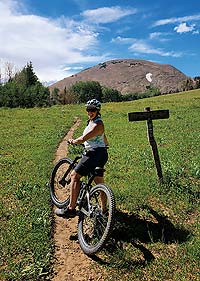|  Have you ever been on a ride, feeling awesome, thinking you are looking pretty much like Aaron Gwin on a world cup downhill track? Then it happens, you smack a hole in a turn, your front wheel folds up under you, and before you can blink you are flying OTB on your way to a dirt nap; instantly looking like Gwin during his famous crash in Ft. William, Scotland in his race run in early June of 2019. Have you ever been on a ride, feeling awesome, thinking you are looking pretty much like Aaron Gwin on a world cup downhill track? Then it happens, you smack a hole in a turn, your front wheel folds up under you, and before you can blink you are flying OTB on your way to a dirt nap; instantly looking like Gwin during his famous crash in Ft. William, Scotland in his race run in early June of 2019.
What happened to Aaron was pretty rare for a rider of his caliber and probably had something to do with a somewhat slippery bridge on the entrance to the corner, however, itís a good illustration for the extreme case of exploding in a corner. What makes mountain biking fun is the fact that there are obstacles in the trail and irregular terrain. Many times, these obstacles are in the beginning, middle, or exit of a turn. When you are reading the terrain and picking your line, here are a few steps to take:
1 - Imagine you are an F1 driver, and you want to use the WHOLE trail for your corner setup, apex, and exit. Set up wide, apex, then drift wide at the exit to maintain maximum momentum .
2 - Identify obstacles that will narrow your ability to use the whole trail and adjust your line accordingly.
Here are a few techniques to use in turns with obstacles:
The Double Apex. This is a technique used to avoid an obstacle that is near the actual apex of the turn. You turn some before the obstacle and some after the obstacle; a net gain of making the whole corner radius, but broken down into two quick turns in the same direction.
The Apex Unweight. This is a super helpful technique that will increase your flow on trail. Because many trails get ridden by many riders in the exact same line, holes get created in the turn, in the ideal line. It doesnít make sense to go around the hole, but itís slow and rough to go through the hole. The best solution many times is to unweight and float over the hole, while staying on the main line and the best radius of the turn.
I watched this technique demonstrated by Eric Carter in a dual slalom race in Sandpoint Idaho. The 180 degree berm was blown out (big wet soft rut/hole) right at the apex from all the riders pushing into the turn really hard. Each rider was losing tons of momentum every time they apexed the turn at the hole. EC (Eric Carter) came through at the same speed as everyone else, pushed into the berm early, became super light in the apex, floated over the hole, pushed again just after the hole, and his exit speed was double the other riders. His line and turn radius was the same as everyone else, he apexed the turn same as everyone else, he was just very selective on where he was heavy and light on the bike to maximize momentum.
The Apex Hop. This is the same idea as the apex unweight, only here you are actually hopping over an obstacle, like a rock or root that protrudes into the line. This is used in lieu of doing a double apex. Instead of going around the obstacle, bunny hop over it and stay on the best radius line you can, ultimately creating more flow. This generally means you are reading the trail really well. Most riders are probably doing a double apex, but you turn the double apex into a single apex because you create a fluid turn by hopping over something instead of turning twice.
 Off-Camber Turns. Probably one of the best feelings on a bike is sticking a high off-camber line that very few other tracks are visible on. The main line falls down the fall line and terminates in an obstacle, an uphill or something less desirable than sticking to the high side and maintaining momentum. For off-camber traction, make sure you are balanced on the bike and have good pressure on your hands and feet. Use the same techniques as above, weight and unweight the bike where you see less and more traction, and donít be afraid to hop over some obstacles that try to force you off the preferred line. Off-Camber Turns. Probably one of the best feelings on a bike is sticking a high off-camber line that very few other tracks are visible on. The main line falls down the fall line and terminates in an obstacle, an uphill or something less desirable than sticking to the high side and maintaining momentum. For off-camber traction, make sure you are balanced on the bike and have good pressure on your hands and feet. Use the same techniques as above, weight and unweight the bike where you see less and more traction, and donít be afraid to hop over some obstacles that try to force you off the preferred line.
Tracking is a term you may hear when people talk about characteristics of a bike. Tracking is when the bike sticks to a line in off-camber situations. One thing that can help with tracking is to reduce the tokens/air spring spacers in your suspension. Doing this makes the suspension more linear, less progressive. In other words, your suspension will have less ramp up and bottom out support. It will have a more linear feel throughout its travel stroke, less bottom out support. This setup allows the suspension to move more freely throughout the travel, creating more traction on terrain like off-camber areas.
All these techniques start with eyes up, ride from your core, elbows out. Go Shred!
 Bike Rentals - Apparel - Gear - Swag Bike Rentals - Apparel - Gear - Swag
702 South Main Street
435 259 4688
www.chilebikes.com
|